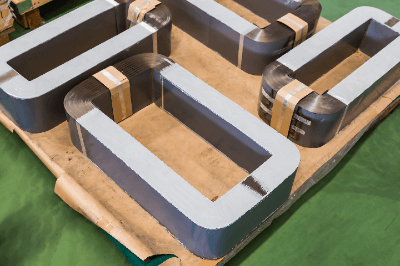What Is an Amorphous Metal?

Amorphous metals are metals with an amorphous structure.
Amorphous metals are subjected to rapid cooling, resulting in an amorphous structure in which the atoms are randomly arranged without crystallization. Because it is amorphous and free of defects caused by grain boundaries, it has a higher strength and is therefore very strong. It also has very elastic and deformation-resistant properties and has high electrical and thermal conductivity.
Applications of Amorphous Metals
1. Automotive Industry
Examples include automotive silencers and weatherproofing of chimneys.
Automotive silencers are part of an automobile’s exhaust system, a device used to reduce the noise of exhaust gases emitted from the engine. Weatherproofing of chimneys is a treatment to prevent corrosion and deterioration that occurs when chimneys are exposed to the external environment.
2. Electronics Industry
Examples include magnetic sensors, solar cells, electronic circuits, and memory.
Magnetic sensors are a type of sensor that detects magnetic fields and converts the information into electrical signals. Solar cells are devices that receive sunlight and convert its light energy into electrical energy. Solar cells generate direct current electricity in response to the intensity of sunlight.
3. Power and Energy Industry
Examples include the iron cores of column transformers, industrial transformers, and small- and medium-sized motors. A column transformer is a type of transformer used to convert high-voltage power from transmission lines into low-voltage power.
4. Machinery Industry
This includes bearings, gears, shafts, nozzles, etc.
5. Magnetic Device Industry
Magnetic head elements and magnetic heads for HDDs are examples. Magnetic head elements are components that contact the surface of magnetic media (e.g., hard disks) to read magnetic information and are usually made in very small sizes.
6. Chemical and Medical Industries
Catalytic materials, taking advantage of their catalytic properties, electromagnets, MRI magnets, etc., take advantage of their superconductivity.
Properties of Amorphous Metals
Amorphous metals do not have the crystalline structure of normal metals, but have an amorphous structure with an irregular arrangement of atoms. For this reason, they have different physical properties compared to crystalline metals. It has extremely high strength and hardness. It is a material that is approximately twice as strong and three times harder than ordinary metals. It also has excellent corrosion resistance, and an oxide film can be formed on the metallic glass surface to improve the corrosion resistance of the metal surface.
Amorphous metals are soft magnetic materials with excellent magnetic properties (excellent magnetic response to magnetic fields) because they do not have the anisotropy of crystalline metals. Their amorphous structure and high thermoplasticity enable the manufacture of parts and products with complex geometries.
Amorphous metals with catalytic properties are used in fuel cells and as catalysts for chemical reactions, while those with hydrogen storage capabilities are used to store and transport hydrogen energy.
Normal metals have a regular lattice structure, and when deformed, crystal grains move among each other, causing deformation. Amorphous metals, however, do not have a crystal structure and there is no movement of crystal grains during deformation, so they easily retain their strength due to intermolecular bonding forces. Since the intermolecular distance is very short and the modulus of elasticity is high, amorphous metals retain their strength even after deformation, and their high resistance to brittle fracture allows them to retain their strength even after repeated deformation.
Amorphous metals have randomly arranged atoms and no grain boundaries or lattice defects, so the flow of free electrons is not restricted. Therefore, they have very low electrical resistance and high conductivity. Amorphous metals also have a high thermal conductivity due to their amorphous structure, making them suitable for use in high-temperature environments.
Other Information on Amorphous Metals
1. Use as Superconductive Materials
Some amorphous metals are also used as superconducting materials. Superconductivity is a phenomenon in which electrical resistance completely disappears when an electric current is passed below a certain temperature. Some amorphous metals exhibit this phenomenon.
2. Use as Glass Metal
Amorphous metals are a type of metallic glass with an amorphous structure. Unlike ordinary glass, metallic glass has a very low coefficient of thermal expansion, which makes it highly durable and resistant to thermal shock.